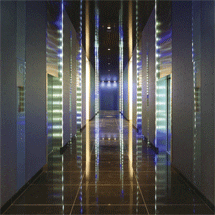
 There is something incongruous about the word “greenscraper”. Even though it slips easily into architectural vernacular, it is a difficult term with which to grapple.
There is something incongruous about the word “greenscraper”. Even though it slips easily into architectural vernacular, it is a difficult term with which to grapple.
On the one hand, Foster + Partners’ new high rise is the fourth tallest skyscraper in London’s Square Mile. The Willis Building is bold and brash, boasts more than 5,000 tonnes of steel and has piled foundations the length of four-and-a-half London buses. Twenty-one high-speed lifts travel the 125m-high building at 15 miles per hour, taking staff from the ground to the top floor in a matter of seconds. Thirty thousand people spent a total of 1.5 million man-hours taking the project from inception to completion.
But the building excels in terms of its BREEAM (Building Research Establishment Environmental Assessment Method) ratings and was awarded 10/10 for its low energy consumption. The high standards of sustainable construction were also commended – material from the demolition of the building was recycled and crushed for use in the foundations
of the new structure, reducing both wastage and road miles.
The glass facade incorporates high-efficiency double-glazing, and the distinctive saw-tooth design – apart from enhancing the silhouette – prevents overheating, reduces the usage of air-conditioning and optimises the amount of natural light coming into the building.
Only about one in five new builds achieves excellence in its BREEAM rating, with the proportion in London far lower. For a skyscraper to achieve it is a particularly tall order. But if any building was going to hit such heights, it was going to be the Willis Building. The team behind this new addition to the London skyline is the architectural equivalent of a super-group, with Foster at the helm, British Land as the developer, Stanhope as the manager and global insurance broking company Willis laying claim to the whole tower.
The green theme is at the heart of the structure. StructureTone, the company behind the fit out, managed to carbon offset the project in keeping with the core build. The building is the UK’s first Forestry Stewardship Council-accredited fit out and a wide range of initiatives were introduced to reduce the carbon footprint of the development. These included a 50 per cent decrease in the haulage of CO2 through the use of a consolidation centre, and a recycling rate of over 85 per cent. Mineral fibre tiles, which produce 80 times less CO2 than their metal equivalent, were used in the ceiling.
Foster + Partners designed the lift lobby, a show-stopping glossy affair with mood lighting and reflective ceilings, giving a modernising effect to the rest of the fit out.
The interior of the building is a corporate fit out to suit a high-end insurance broker. Designed by Swanke Hayden Connell Architects, it includes a 375-seat auditorium, a fully equipped gym and restaurant to accommodate the 2,000 plus staff with its own outdoor terrace.
The three roof terraces are a highlight of the finished build. The highest and most impressive, the Client Advocate roof terrace, is used for corporate entertainment and dining, and takes in views of the whole of the city.
The statement, however, is in the building – and it is most definitely a trumpet blow that will be heard across the City. In 2007, Willis’ New York division moved into first-class office space at One Financial Centre. Lloyds previously occupied the company’s London site, at 51 Lime Street, before it moved to 1 Lime Street, opposite the new development. Willis really is placing itself at the heart of the insurance sector.
When developer British Land was looking for a tenant for the new build and approached Willis, some unusual adjustments had to be made. The insurance broker wanted a tower that it could occupy exclusively. British Land’s head of London leasing, Paul Burgess, says: “It was probably the first time we had ever gone to the city planner and asked to make a build smaller.”
The changes went ahead; it was a collaboration that everyone wanted in on.
The project is not the first time Willis has worked with Foster + Partners. The three-storey Willis Building in Ipswich was designed by the company’s previous incarnation, Foster Associates, in 1974, and given Listed status in 1991.
The new headquarters have been developed as a series of overlapping curved shells, with the sections arranged in three steps. Roof terraces overlooking London are directly accessible from three floors of the office tower. More than 2,000 Willis staff, from four offices across London, have moved into the 28-storey build.
An adjacent nine-storey building, 1 Fenchurch, which is part of the same development, has been part let to a law firm.
Both buildings have an open and integrated area at street level, more in keeping with nearby Leadenhall Market with its shops and cafes than a financial district.
The smaller building’s concave facade shapes the public plaza that both buildings step down to. Its curved corners maintain important view corridors, as well as reinstating a historic route through the site. A fringe of shops, cafes and bars at its base, together with linear seating and landscaping, combine to enhance the public realm.
Both buildings have a central core to provide open floorplates and maximum flexibility in use. The entire development is unified visually by its highly reflective facade.
The Willis Building won the 2007 New City Architecture Award, not only for its architectural form, but also for its contribution to the streetscape of the City.
Chief executive Joe Plumeri says that for a global giant such as Willis, the move also shows commitment to London as one of the world’s leading financial centres. “I have no idea what the BREEAM means, but I am guessing that it is a real good thing.” For him, it is about modernising – and standing tall. The glass structure certainly achieves both these goals.






















